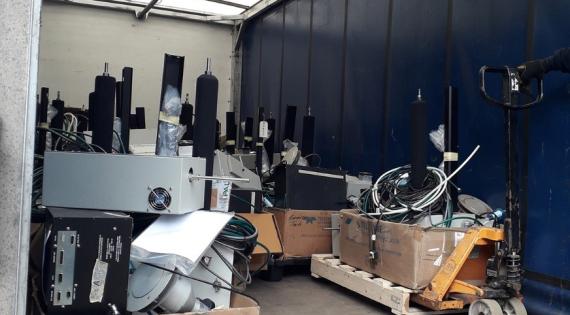Gemma Purser takes us on a significant journey for air quality monitoring equipment from the UK to Africa...
0 miles: Every great journey starts with an idea
Every great journey has a beginning and this one begins in the UK, with a large white box in a field, or on a street, near a town, or in a city. Inside is a reference air pollution monitor, pulling in the air around it every hour, day, week, month and year. Importantly it is monitoring the quality of the air we breathe, giving us information about the sources and strength of air pollution and ultimately allowing us to make decisions about how we can improve air quality.
These reference instruments around the UK are part of the UK Automatic Urban and Rural Network (AURN) owned and managed by the Environment Agency. For many years the instruments measured UK air but in September 2020, following a decision to change the methods used in the AURN network, the Environment Agency donated 65 instruments to continue their lives as part of other air quality networks. UKCEH is one of the organisations which monitors air quality as part of the AURN network.
Dr Christine Braban, UKCEH’s atmospheric composition group leader, takes up the story:
"I was in a field in Cumbria measuring air quality with Environment Agency staff in September 2020 when I learned that their TEOM monitors were being retired for a different technology. For many years UKCEH has ‘adopted’ instruments coming out of UK Air Quality networks, whether for policy change or operational reasons. This helps ensure continued use for research and extends the working life of the instruments.
In 2019 I had attended an IGAC Africa Scoping meeting in which the need for reference air quality instrumentation was raised. When I learned the AURN instruments were being retired, I reached out to the African Group on Atmospheric Sciences (ANGA) to see if they could use them. From there the idea of donating the equipment gathered pace, with the Natural Environment Research Council, the Clean Air Fund and the Environment Agency all supporting the refurbishment, checking and donation of the instrumentation."
Rob Jones of the Environment Agency adds:
"It’s great to see our network analysers being re-used and providing useful data abroad where air quality measurement networks are developing, rather than being unnecessarily disposed of when our own network needs evolve. We are grateful to the hard work of the UKCEH project team for progressing this and were happy to provide administrative support to see the analysers being re-homed in this manner."
100 miles: The journey begins
In a workshop on a business park in Gloucestershire the team at EnviroTechnology Services have received the first of the instruments. The skilled technical staff are carefully checking over the instruments, cleaning the inside, and servicing the instruments to make them run smoothly and make sure the correct measurements of air are being made. Twenty-five of the instruments are processed and ready for the next stage of their journey to Africa.
But what is the instrument in the box?
A TEOM, or TEOM-FDMS to give its full name is a Tapered Element Oscillating Microbalance with a Filter Dynamics Measurement System. These instruments measure tiny particles (particulate matter or PM) in the air in real-time. These particles can come from natural sources such as sand or sea-salt or from sources related to human activity, such as burning wood, cooking and driving vehicles. These reference air pollution monitors are used to help us understand the "quality" of the air. The more particulate matter that can be found in the air, the lower quality it is and the more likely it is to have a bad effect on human health.
Importantly for our story, TEOMS are workhorses - machines that you can rely on to work hard over a long period of time. The working life of a well-maintained TEOM is decades. They are known as reference grade instruments as they give traceable and robust measurements of particulate matter. They can be used to assess other often smaller, lower cost or simpler sensors that also monitor air pollution to check that they are giving good information on the amount of particulate matter in the air.
"Importantly for our story, TEOMS are workhorses - machines that you can rely on to work hard over a long period of time."
EnviroTechnology (ET) told us more about their role in the project:
“Following an upgrade of the PM analysers on the UK AURN network, initiated by the UK Government, ET fully tested and serviced the superfluous instruments before they were despatched from the UK to Africa. We continue to provide technical assistance to the end users in Rwanda and Ghana. ET are pleased to be involved in this project where we can offer our expertise to support communities in need.”
